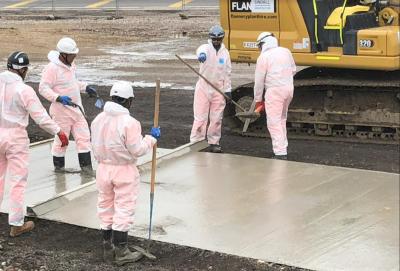First Graphene has completed the second phase of its graphene-enhanced cement trials, alongside the UK’s largest cement producer Breedon Cement. The first phase demonstrated a 15% reduction in carbon emissions and 10% increase in cement strength, reinforcing graphene-enhanced cement as a lower-carbon solution for construction companies around the world. The material made during the Phase One trials also successfully met performance criteria in the end systems, demonstrating the viability of producing graphene-enhanced cement at industrial scale.
The Phase Two trials used four tonnes of grinding aid containing PureGRAPH® to produce an additional 600 tonnes of graphene-enhanced cement at the production scale. The focus was on the optimization of dosing methods at an increased graphene loading level, with the resulting formulation change in the grinding aid. This stage builds on the learnings from earlier work, with results expected in January 2024 which will be used to compare performance to the Phase One trials.
Initial results released from the Phase One trials, which included use of cement produced in the construction of a high-volume car wash-down facility, has seen First Graphene enter early-stage discussions with a UK Government agency to optimize graphene-enhanced cement’s performance to meet its needs, focusing on early-stage strength gain.
Ongoing collaboration with Breedon is now supported through the signing of a Development and Commercialization Agreement with First Graphene, setting out how the companies will work together to develop a range of graphene-enhanced solutions designed to reduce Breedon’s carbon emissions footprint associated with cement production.
The decision to partner with the UK’s largest cement producer is a significant step forward in First Graphene’s commercialization strategy for its range of PureGRAPH® products, given Breedon’s production of more than two million tonnes of cement annually and the growing global demand for green cement.
In addition, First Graphene has shared that its representatives visited Holcim (New Zealand) Ltd., following the New Zealand Cement and Concrete Conference, to view the global cement producer’s Low-Carbon Cement Replacement Facility. Holcim NZ has been testing First Graphene’s PureGRAPH® product as an additive to increase the performance of Supplementary Cementitious Materials (SCM), with the aim of reducing CO2 emissions in the sector and increasing performance of cement blends to extend the range of applications. Currently, Holcim NZ are working on identifying the optimum PureGRAPH® product to achieve this goal, and the corresponding addition method.
First Graphene has also commenced collaborative trials with Thailand-headquartered Siam City Cement (“Siam City Cement” or “SCCC”), targeting lower clinker content in their cement products while maintaining good cement quality. Lab-scale testing is currently underway, with the aim of determining the ideal PureGRAPH® product for their cement composition.
First Graphene’s commercial partner GtM Action (“GtM”) recently commenced trials in New Zealand of PureGRAPH®-enhanced sand, with the aim of validating an improved method to incorporating graphene into dry mix cement. First stage trials are designed to investigate if sand as a graphene carrier would practically work in GtM’s current cement production process, and results are expected imminently. Future stages have been designed to test the mechanical performance of graphene-enhanced sand in concrete slabs. Trials are ongoing to assess whether graphene-enhanced sand could be easier to handle than liquid alternatives, therefore providing a more readily accessible product for the slabs that GtM manufactures. The slabs are used as insulation, protecting ceramics from furnaces during construction, and while it is a specialty application, the trial allows PureGRAPH®-enhanced sand testing in a commercial project.
First Graphene has commenced early-stage discussions with LKAB Minerals, which is the international industrial minerals division of LKAB. LKAB is an international mining and minerals group that offers sustainable iron ore, minerals, and special products. The specific focus is on the optimization of their granulated blast furnace slag (GBFS) processing facility in the UK. The intention is to assess the effectiveness of graphene as both a grinding aid and additive in granulated GBFS-based binders. Initial work will be conducted at the laboratory-scale, and a successful outcome, which demonstrates no adverse impact on customers, would be an enabler to a full production scale trial.


